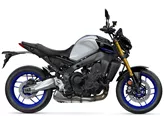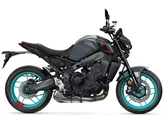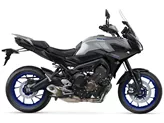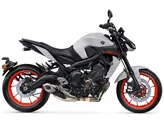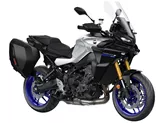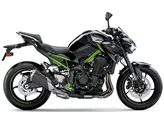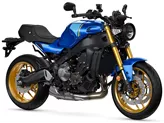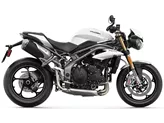Kawasaki ER-6n 2013 vs. Yamaha MT-09 2017

Kawasaki ER-6n 2013

Yamaha MT-09 2017
Overview - Kawasaki ER-6n 2013 vs Yamaha MT-09 2017
The Kawasaki ER-6n 2013 and the Yamaha MT-09 2017 are both naked bikes with similar engine types and cooling systems. However, there are several notable differences between the two models.
In terms of engine power, the Yamaha MT-09 2017 has a significant advantage with 115 HP compared to the Kawasaki ER-6n 2013's 72 HP. The Yamaha also has a higher torque of 87.5 Nm compared to the Kawasaki's 64 Nm. This difference in power and torque translates to a more exhilarating and dynamic riding experience on the Yamaha.
Both bikes have a monoshock rear suspension and double disk front brakes. However, the Yamaha MT-09 2017 has an advantage in terms of its chassis. It features an aluminum frame, which is lighter and more rigid compared to the steel frame of the Kawasaki ER-6n 2013. The Yamaha also has a twin tube frame, which further enhances its handling and stability.

Kawasaki ER-6n 2013
In terms of tire dimensions, both bikes have a front tire width of 120 mm and a front tire diameter of 17 inches. However, the Yamaha MT-09 2017 has a wider rear tire with a width of 180 mm compared to the Kawasaki ER-6n 2013's 160 mm. This wider rear tire provides better traction and stability during cornering.
The Yamaha MT-09 2017 also has a slightly longer wheelbase of 1440 mm compared to the Kawasaki ER-6n 2013's 1410 mm. This longer wheelbase contributes to the Yamaha's stability at high speeds.
In terms of weight, the Yamaha MT-09 2017 is lighter with a kerb weight of 193 kg compared to the Kawasaki ER-6n 2013's 208 kg. This lighter weight contributes to the Yamaha's agility and maneuverability.
Both bikes have a fuel tank capacity of around 14-16 liters, with the Kawasaki having a slightly larger capacity.

Yamaha MT-09 2017
In terms of strengths, the Kawasaki ER-6n 2013 is praised for its solid handling and high-quality level. On the other hand, the Yamaha MT-09 2017 has several strengths including an Öhlins suspension, Akrapovic exhaust for improved optics and sound, a Magura HC3 radial brake pump for excellent braking performance, and Carbon2Race covers for a grandiose appearance. The combination of seat, footrests, and handlebar clamps on the Yamaha is also highly effective.
In terms of weaknesses, the Kawasaki ER-6n 2013 is criticized for its weak brake performance. The Yamaha MT-09 2017, on the other hand, has some weaknesses such as the financial outlay required for modifications, the significant amount of working time needed for certain modifications, and the fact that some parts may need to be registered. Additionally, the ECU Flash modification on the Yamaha is not road legal.
Overall, the Yamaha MT-09 2017 offers a more powerful and dynamic riding experience with its higher engine power and torque, lighter weight, and improved chassis. However, it is important to consider the additional costs and legal implications of modifications on the Yamaha. The Kawasaki ER-6n 2013, on the other hand, provides solid handling and a high-quality level without the need for extensive modifications.
Technical Specifications Kawasaki ER-6n 2013 compared to Yamaha MT-09 2017
Pros and Cons in comparison
Pros and Cons in comparison
Kawasaki ER-6n 2013

The engine is hearty and a lot of fun, plus the ER shines with a Japanese meticulous finish and a fighting price.
Yamaha MT-09 2017

In conclusion, after several stops throughout the season, I can look back on a great result. Both in terms of performance and looks, our MT-09 is perfect. The suspension was probably our most important issue. Where before there was clearly (too much) movement in the rear in fast corners, now it is ironed over without batting an eyelid. The STX 46 shock absorber is quite stiff in its basic configuration, but also manages to get through everyday life without being uncomfortable. Thanks to generous adjustment options, there is still room for individual preferences and uses. The function of the NIX 30 cartridge is also impressive. The response behaviour - especially under load - has improved significantly. There is now also much more reserve available when braking. Where before the fork went into block and the ABS triggered when braking hard with the original set-up, now the brakes simply continue to work effectively. In addition, the MT-09 now follows the intended line in the curve radius as if by itself - a pure pleasure. The sight and sound of the Akrapovic complete system are also pure joy, and the fact that it produces a few more horsepower is felt effectively, especially in the upper third of the rev range. The front wheel shoots even more willingly into the gallery in 2nd and 3rd gear.
Price Comparison Avarage Market Price Kawasaki ER-6n vs Yamaha MT-09
There are a few key differences between a Kawasaki ER-6n 2013 and a Yamaha MT-09 2017. It takes less time to sell a Kawasaki ER-6n with 42 days compared to 73 days for a Yamaha MT-09. Since model year 2006 1000PS.de editors have written 16 reviews for the Kawasaki ER-6n and 57 reviews for the Yamaha MT-09 since model year 2013. The first review for the Kawasaki ER-6n was published on 29/06/2005 and now has more than 11,200 views. This compares to more than 39,900 views for the first review on Yamaha MT-09 published on 10/06/2013.






